Purpose
The C-group is an innovative, experiential, and transformative learning methodology that enables a small group of people to practice and develop their interpersonal and conversational skills. These competencies are critical in a complex world.
Group size
The group size is 6 to 12 people. The ideal size is 10 people.
C-group duration
A C-group consists of multiple two-hour sessions (90 minutes group-led conversation, 30 minutes facilitator-led reflection)
C-group room
The participants sit in a tight circle along with the C-group host. There are no tables, notepads, or flip-charts in the room.

C-group host
The host doesn’t choose the topic of conversation. Also, the host is not there to teach or coach the participants. The host is there to ensure a balance of psychological safety and group learning.
C-group process
A C-group does not have an explicit agenda, structure, or expressed goal.
The conversations are self-led by the group and not by the host. This procedure contrasts with many workshop formats where the facilitator pre-defines the content, questions, or activities.
As the group starts to discuss the problems caused by a lack of direction, they tend to act in characteristic ways; some stay silent, some become aggressive, some consistently try to initiate discussions, while others attempt to provide structure to the conversation.
The host does not intervene in what might seem like chaos at times but draws attention to events and behavior in the group by occasional interventions in the form of judgment-free observations.
It is up to the group to resolve their issues and learn from the conversation.
Kicking-off a series of C-group sessions
These are some words a C-group host might use to kick-off a series of C-group sessions:
This C-group session is the first of several 2-hour long sessions.
In these sessions, I am going to act more like a host than a facilitator.
C-group sessions do not have an explicit agenda, structure, or expressed goal.
This is YOUR time to talk about whatever you like, in whatever way you like.
Given the lack of structure, it is likely to be challenging and awkward at times. This is deliberate and inherent in the nature of C-group conversations.
I will not intervene, even if things get difficult. Still, I will be observing the conversational dynamics, and occasionally I will draw attention to patterns of behavior in the group by pausing the conversation and making judgment-free observations. For example, “I am noticing that not everyone is engaged in this conversation right now.”
It is up to you to resolve any issues and learn from the conversation.
During the session, I would like you to observe your own behaviors and that of the group and, in your head, ask yourself the following three questions.
- What is the conversation we need to be having right now?
- What is the way we should be having this conversation right now?
- Are we building a community right now?
Credit: The C-group has been developed by John Hovell. The process is still evolving. It shares some characteristics with the well-known T-group training process.
POST NAVIGATION
CHAPTER NAVIGATION
SEARCH
Blook SearchGoogle Web Search
Leadership as a practice of convening necessary conversations—ones that often go unsaid. Coaching that supports clarity, presence, and more thoughtful ways of working together.


Great, indeed something I intend to do at my workplace, also because I run some sessions that are similar already.
Jan
This is just a sketchy outline as yet Jan. John Hovell and I will be working together to expand it. When we next talk it would be good to hear what you are doing and what you have planned.